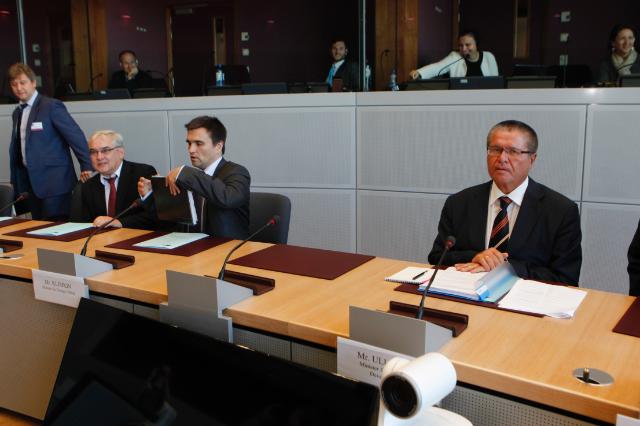This meeting was the last chance to find a common understanding ahead of the provisional entry into force of the DCFTA between the EU and Ukraine on 1 January 2016, - The European Commission's statement says.
Throughout the process the EU and Ukraine were confronted with requests by the Russian side, in particular to formalise mutual obligations that were neither related to specific concerns nor aimed at obtaining practical solutions.
The European Commission published a document shedding some light on certain myths related to Trilateral talks on EU-Ukraine DCFTA.
Myth 1: Russia can change CIS-FTA customs rules without having to hold consultations with all other CIS-FTA countries.
Under CIS-FTA safeguards rules (annex 6), in order to increase import tariffs against another CIS-FTA member (e.g. Ukraine), Russia must:
- consult the other countries of the CIS-FTA;
- demonstrate product by product that the changed circumstances (i.e. the provisional application of the EU-Ukraine DCFTA as of 1 January 2016) would lead to 'an increase in imports from the Party in such quantities as to cause damage or threaten to harm the industry of Custom Union'.
Currently, Russia neither demonstrated such an increase in imports or related negative effects stemming from the implementation of the DCFTA because the DCFTA has not yet come into force. The Commission has offered to continue the consultations after 1 January 2016. The Commission's offer to continue is however conditional on Russia's revocation of the Presidential decree that suspends it CIS FTA obligations towards Ukraine.
Myth 2: The EU demands that all goods sold on the Ukrainian market should comply with European technical standards. This excludes Russian products from the Ukrainian market.
Russia's request for transition periods postponing the alignment of Ukraine’s regulations with those of the EU would effectively force Ukraine to roll back already transposed EU legislation. This would violate provisions of the DCFTA (Art. 56).
Furthermore, to our knowledge no Russian company has yet complained that it faced difficulties in exporting its products to Ukraine due to technical regulations. After looking more closely into recent trade figures, we see rather an increase in Russian exports to Ukraine in the sectors where Ukrainian regulations have been aligned with EU standards. The share of Russian exports to Ukraine of goods falling under EU-based harmonisation of technical regulations, in line with commitments under the DCFTA, out of overall Ukraine-Russia bilateral trade in goods increased from 8.8% to 12.3% between 2012 and 2014.
This is probably due to the fact that Russia generally has an interest in harmonising its technical regulations and standards with those of the EU in various sectors, as it wants to attract EU investors and to be able to export to the EU in the future. For many years the EU has conducted projects with Russia concerning harmonisation of technical regulation for industrial products.
Read more: Know your refutations to 5 myths that are used to promote Russia's war in Ukraine | Infographic
As such, since 2013, the Commission has been financing a project on 'Approximation of EU and Russian Federation technical regulation and standardisations systems'. This project seems to be fruitful regarding work with the Russian authorities on the approximation of technical regulations, even if in practice some of the legislation is not applied on the ground. The Customs Union (the Eurasian Economic Union since 2015) has adopted 35 technical regulations, a number of which are Page 3 of 3 based on and broadly in line with EU regulations (for example toys, machinery, low voltage, electromagnetic compatibility, personal protective equipment).
In line with the flexibilities foreseen in the DCFTA, the EU is ready to consider longer transition periods for technical regulations linked to certain sectors/goods if Russia demonstrates the need for it. However, until now, Russia has not provided figures on its exports to Ukraine in specific sectors where Ukraine has already aligned or is supposed to align its legislation with that of the EU. Instead, Russia has designated seven sectors to be of particular economic importance for Russia, however, without any factual evidence or clear justification. Ukraine has already approximated its regulations with those of the EU in six out of these seven sectors concerned.
Myth 3: The EU wants to force Russia to change customs rules set in the Free Trade Agreement of the Commonwealth of Independent States (CIS-FTA).
In fact, in the trilateral talks, the Commission simply said that Russia is free to initiate a procedure to change its CIS-FTA rules if it considers that the CIS-FTA rules of origin lead to problems each time a CIS-FTA member signs a Free Trade Agreement (FTA) with another country.
The EU's position is based on its belief that customs rules should be functional and respect the rule that FTAs do not lead to mutual exclusivity of involved partners.
Myth 4: The EU obliges Russia to adopt the EU phytosanitary control system.
It is clear, however, that Russian exports to the EU have to conform to EU SPS standards. In the context of the trilateral talks, the EU has responded to Russian SPS-related concerns about customs cooperation with Ukraine and proposed an updated bilateral process of acceptance of veterinary certificates, the mutual evaluation of SPS systems, a revision of rules of origin within the CIS-FTA, and deeper customs service cooperation to fight fraud.
At the same time, it is doubtful that this would have a positive impact for Russian exports. This Russian proposal is an example of Russia's misinterpretation of the Commission's mandate 'to elaborate practical solutions to Russian concerns linked to the implementation of the DCFTA'.




